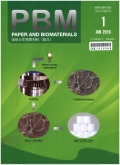- 钛学术文献服务平台 \
- 学术期刊 \
- 工业技术期刊 \
- 化学工业期刊 \
- 造纸与生物质材料(英文)期刊 \
A Review on the Structure and Biodegradation of Cellulose-Lignin Complexes
A Review on the Structure and Biodegradation of Cellulose-Lignin Complexes
基本信息来源于合作网站,原文需代理用户跳转至来源网站获取
摘要:
Cellulose is the most abundant organic macromolecule in nature and is renewable, degradable, and biocompatible. The structure of native cellulose has not yet been completely elucidated. Part of cellulose is tightly combined with lignin macromolecules through chemical bonds to form cellulose-lignin complexes (CLC). The existence of the CLC structure inhibits the complete separation of cellulose from lignocellulosic material, which not only increases the consumption of chemicals in the cooking process and causes environmental pollution, but also makes the cellulose subject to certain degradation during the deep delignification process. Therefore, elucidation of the relationship between the cellulose-lignin connection structure and performance is of great significance for efficient separation of cellulose. This article reviews the current research status of CLC and discusses the research progress regarding its biodegradation characteristics.

推荐文章
Diffusion in garnet: a review
High temperature and high pressure
Diffusion
Garnet
Point defects
Incorporation of silica into the goethite structure: a microscopic and spectroscopic study
Quartz
Goethite
Twinned goethite
Microscopic characterization (FESEM and TEM)
FT-IR spectroscopy
A review of geoanalytical databases
Database
Geochemistry
Geology
Geoanalysis
Information system
内容分析
关键词云
关键词热度
相关文献总数
(/次)
(/年)
文献信息
| 篇名 | A Review on the Structure and Biodegradation of Cellulose-Lignin Complexes | ||
| 来源期刊 | 造纸与生物质材料(英文) | 学科 | |
| 关键词 | |||
| 年,卷(期) | 2020,(4) | 所属期刊栏目 | Cellulose-Lignin Complexes |
| 研究方向 | 页码范围 | 44-50 | |
| 页数 | 7页 | 分类号 | |
| 字数 | 语种 | 英文 | |
| DOI | 10.12103/j.issn.2096-2355.2020.04.006 | ||
五维指标
引文网络
引文网络
二级参考文献 (13)
共引文献 (9)
参考文献 (29)
节点文献
引证文献 (0)
同被引文献 (0)
二级引证文献 (0)
1957(2)
- 参考文献(1)
- 二级参考文献(1)
1959(1)
- 参考文献(1)
- 二级参考文献(0)
1960(1)
- 参考文献(1)
- 二级参考文献(0)
1965(1)
- 参考文献(1)
- 二级参考文献(0)
1980(1)
- 参考文献(1)
- 二级参考文献(0)
1984(1)
- 参考文献(1)
- 二级参考文献(0)
1985(1)
- 参考文献(1)
- 二级参考文献(0)
1986(1)
- 参考文献(1)
- 二级参考文献(0)
1987(1)
- 参考文献(1)
- 二级参考文献(0)
1999(1)
- 参考文献(0)
- 二级参考文献(1)
2001(2)
- 参考文献(0)
- 二级参考文献(2)
2002(2)
- 参考文献(0)
- 二级参考文献(2)
2003(1)
- 参考文献(0)
- 二级参考文献(1)
2004(2)
- 参考文献(1)
- 二级参考文献(1)
2005(1)
- 参考文献(1)
- 二级参考文献(0)
2006(4)
- 参考文献(2)
- 二级参考文献(2)
2007(4)
- 参考文献(2)
- 二级参考文献(2)
2008(1)
- 参考文献(1)
- 二级参考文献(0)
2009(1)
- 参考文献(0)
- 二级参考文献(1)
2010(1)
- 参考文献(1)
- 二级参考文献(0)
2011(3)
- 参考文献(3)
- 二级参考文献(0)
2013(3)
- 参考文献(3)
- 二级参考文献(0)
2014(2)
- 参考文献(2)
- 二级参考文献(0)
2015(2)
- 参考文献(2)
- 二级参考文献(0)
2016(1)
- 参考文献(1)
- 二级参考文献(0)
2019(1)
- 参考文献(1)
- 二级参考文献(0)
2020(0)
- 参考文献(0)
- 二级参考文献(0)
- 引证文献(0)
- 二级引证文献(0)
引文网络交叉学科
相关学者/机构
期刊影响力
造纸与生物质材料(英文)
主办单位:
中国造纸学会
中国制浆造纸研究院
出版周期:
季刊
ISSN:
2096-2355
CN:
10-1401/TS
开本:
出版地:
北京市朝阳区启阳路4号院2号楼
邮发代号:
创刊时间:
语种:
eng
出版文献量(篇)
2305
总下载数(次)
0
总被引数(次)
4356
期刊文献
相关文献
推荐文献
- 期刊分类
- 期刊(年)
- 期刊(期)
- 期刊推荐
一般工业技术
交通运输
军事科技
冶金工业
动力工程
化学工业
原子能技术
大学学报
建筑科学
无线电电子学与电信技术
机械与仪表工业
水利工程
环境科学与安全科学
电工技术
石油与天然气工业
矿业工程
自动化技术与计算机技术
航空航天
轻工业与手工业
金属学与金属工艺
造纸与生物质材料(英文)2022
造纸与生物质材料(英文)2021
造纸与生物质材料(英文)2020
造纸与生物质材料(英文)2019
造纸与生物质材料(英文)2018
造纸与生物质材料(英文)2017
造纸与生物质材料(英文)2016
造纸与生物质材料(英文)2015
造纸与生物质材料(英文)2014
造纸与生物质材料(英文)2013
造纸与生物质材料(英文)2012
造纸与生物质材料(英文)2011
造纸与生物质材料(英文)2010
造纸与生物质材料(英文)2009
造纸与生物质材料(英文)2008
造纸与生物质材料(英文)2007
造纸与生物质材料(英文)2006
造纸与生物质材料(英文)2005
造纸与生物质材料(英文)2004
造纸与生物质材料(英文)2003
造纸与生物质材料(英文)2002
造纸与生物质材料(英文)2001
造纸与生物质材料(英文)2000
造纸与生物质材料(英文)1999

 免费查重
免费查重










